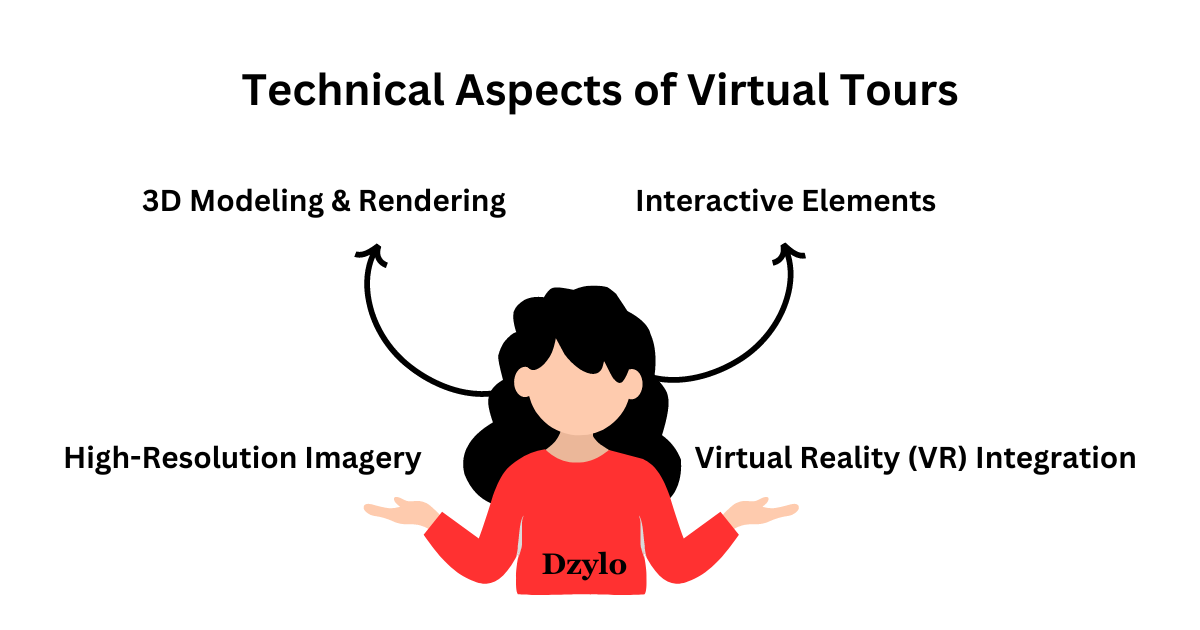Interior design can be a complex journey for clients. They often struggle to visualize the outcome from static images and 2D plans, leading to miscommunications and costly revisions. Clients are left feeling frustrated when the design doesn’t match their expectations. In this case, virtual tours in interior design become useful.
Therefore, your agency can offer an immersive and interactive experience through virtual tours. It would allow your clients to explore their future spaces in a way that static images simply cannot. Thus, this technology transforms the design process, making it smoother, more efficient, and enjoyable for both clients and designers.

Virtual tours help bridge the gap between imagination and reality, providing a clear, realistic view of the finished project. As a result, clients feel more confident and involved, which leads to higher satisfaction and fewer surprises down the road.
Why Virtual Tours?
Modern interior designers are increasingly relying on virtual tours. But why the shift? Let’s try to know the reasons behind this.
Less Design Revisions and more satisfaction: Clients often find it hard to visualize 2D plans and static images. Virtual tours provide a 3D immersive experience. Clients can explore spaces, understand spatial relationships, and grasp design concepts better.
Therefore, such enhanced visualization helps them see the designer’s vision clearly and reduces the gap between expectation and reality.
Better Understnding and Communication: On the other hand, communication is crucial in interior design. Virtual tours bridge the gap between designer and client. They let prospects see precisely how the designer intends, avoiding misunderstandings and ensuring that everyone is on the same page.
Early Issue Identification And Better Decision Making: Virtual tours helps point out the errors and issue in the interior design quickly and early – this helps in fixing it and better decision making as they are able to visualise the impact of the design choices.
Consequently, if there’s any 3D tour software, clients feel more involved in the process and confident in their decisions.
How Virtual Tours in Interior Design Help in Cost-Effective Revisions?
Traditional design revisions can be time-consuming and expensive. With virtual tours, clients can suggest changes during the virtual walkthrough. It allows designers to make adjustments before any physical work begins, saving time and money. As a result, both parties benefit from a smoother, more cost-effective process.
Boosting Client Confidence
Clients are more likely to commit to a project when they can visualize the final outcome. Virtual tours instil confidence by providing a realistic preview. This boosts client satisfaction and increases the likelihood of project approval.
Therefore, designers who use virtual tours often experience higher client retention and satisfaction rates.
Showcasing Expertise
Virtual tours highlight a designer’s expertise and technological proficiency. This modern approach sets designers apart from competitors and appeals to tech-savvy clients. It demonstrates a commitment to innovation and quality, which can be a significant advantage in a competitive market.
Technical Aspects of Virtual Tours
To fully appreciate the benefits, it’s essential to understand the technical components of virtual tours in interior design. Here’s a closer look at the technology behind these immersive experiences.
- High-Resolution Imagery:
High-resolution images are crucial for virtual tours. They provide detailed, realistic visuals, ensuring clients can see every element clearly. This includes textures, colours, and finishes, all of which contribute to an accurate representation of the design. Thus, clients can make informed decisions based on clear, high-quality visuals.
- 3D Modeling & Rendering:
3D modelling software creates detailed, accurate representations of spaces. This technology allows designers to create realistic models, which can be rendered into interactive virtual tours. Therefore, designers can showcase their projects through vTour App in a more engaging and informative way.
- Interactive Elements:
Interactive elements enhance the virtual tour experience. Features like clickable hotspots, 360-degree views, and walkthrough capabilities allow clients to explore designs in depth. These elements make the tour more engaging and informative, enabling clients to interact with the design in a meaningful way.
- Virtual Reality (VR) Integration:
Virtual reality takes virtual tours to the next level. VR headsets provide an immersive experience, allowing clients to walk through spaces as if they were physically there.

3d architectural rendering software for free is becoming more accessible and affordable, making it a valuable tool for designers. Consequently, clients get a more realistic feel of the space, enhancing their overall experience.
Implementing Virtual Tours in Interior Design Process
Now that we’ve covered the benefits and technical aspects, let’s explore how to implement virtual tours in your design process.
Creating High-Quality Models
Selecting the right software is always crucial. Consider your needs and budget. So, choose a platform that aligns with your project requirements. Therefore, ensure that the software you select meets your specific design and client interaction needs.
Invest time in creating detailed, accurate models. High-quality models enhance the virtual tour experience and ensure clients can visualize the design accurately. Hence, pay attention to details like lighting, textures, and finishes.
This attention to detail makes the virtual tour more realistic and engaging for clients.
Incorporating Client Feedback
Virtual tours are a collaborative tool. Here, the best 3d architectural rendering software for free can help architects a lot.
Use them to gather client feedback and make necessary adjustments. Encourage clients to explore the tour and provide input. Thus, such a collaborative approach ensures the final design meets their expectations and creates a positive designer-client relationship.
Marketing Your Virtual Tours
Virtual tours are also a powerful marketing tool. Exhibit them on your website and other suitable platforms. Highlight the benefits and unique features of your architectural designs. Use these tours to attract new clients and demonstrate your expertise.
By doing so, you can set yourself apart from competitors and showcase your innovative approach.
End Note
Virtual tours are transforming the interior design industry. Virtual tours in interior design significantly enhance visualization, improve communication, and streamline project revisions. By embracing this technology, modern interior designers can provide exceptional client experiences. The future of interior design is here – are you ready to step into it?
If interior designers adopt virtual tours, they can revolutionize their approach and deliver a more engaging, transparent, and efficient design process for their clients. Moreover, these tools not only elevate the client’s experience but also enhance the designer’s ability to present and refine their vision seamlessly.
Hence, stay ahead of the curve by integrating virtual tours into your design process and showcasing your expertise. Contact the experts at Dzylo to get the best tool for interior designers.
